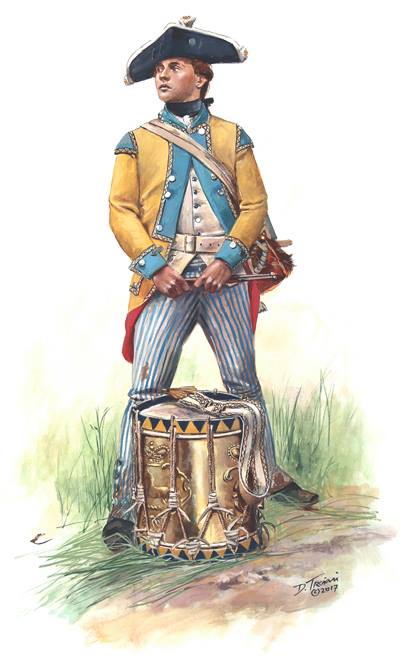German-authored accounts of the Revolutionary War frequently include derisive comments about the clothes worn by their enemies. Many were dressed in torn rags of different colors or miserable outfits typically worn by poor farmers. The obvious lack of neatness and uniformity contrasted starkly with the outfits worn by men belonging to German regiments, at least in the first phase of the war. From the Germans’ perspective, the rebels hardly looked like soldiers.
German soldiers took great pride in their appearance. They wore distinctive uniforms and accessories that identified them as belonging to a particular regiment. The outfits tended to be quite colorful. For example, these were the uniforms of officers and privates belonging to the Hessian Regiment von Mirbach:

The document included with this post lists the material and items needed to complete the outfit worn by drummers belonging to the Braunschweig Regiment von Riedesel. The men wore yellow coats with red lining, white buttons, and light blue lapel facings and collars. Various ribbons, braids and tassels adorned the clothing as well as their drums. Here is a modern rendering of what they would have looked like:

The cloth required to tailor the uniforms was measured in ells (“Ellen”), a unit that was originally based on the length of one of the long bones in the forearm. Late eighteenth century German-English dictionaries give the length of one English ell as 1 1/4 yards (1.143 m or 45 inches) (Johann Ebers, Vollständiges Wörterbuch der Englischen Sprache für die Deutschen: nach den neuesten und besten Hülfsmitteln mit richtig bezeichneter Aussprache eines jeden Wortes [Leipzig, 1793-1794].) The document included with this post details the materials and cost for a drummer’s outfit. It also lists the tailor’s wages and the total expenses for ten uniforms. The currency is listed in pound, shilling, and pence.

ENGLISH TRANSLATION


GERMAN TRANSCRIPTION

Citation: “Mondierungs Anschlag von des General Major von Riedesel Regiment excl. der Augmentation Anno 1776,” in folder labeled “Amerika,” Stadtarchiv Braunschweig, H V: 9.

I enjoyed seeing your youtube videos and consume any material related to the “Hessians” during the Revolutionary War. Thanks for this great information on these uniforms! I shall make one for my Son for use in historical programs at Fort Ticonderoga, NY.
LikeLike
You give Gen Riedesel’s first name as Adolf, yet in 3 other references I have it is given as Friederich Adolf von Riedesel. Trivial, admittedly. I remember this because his wife’s name was Friederike ( Charlotte Luise), whose published memoir of the adventure is among my RevWar collection.
LikeLike
The translation of the drummers uniform materials needs a bit up beefing up for a contemporary understanding. Camisole = vest, otherwise in modern English it is a woman’s undergarment. I think ‘rabat’ means lapel facings, but as far as I can tell, rabat is not an English word. ‘Ribbon’ for pants would be better translated as (fabric) tape. This could be used to cinch the back of the pants or fasten the openings at the knees if no buckles are used. Hooks and grommets should read hooks and ‘eyes’. Grommets are a specialized reinforcement holes in fabric. ‘White’ buttons is the correct translation but a bit too literal. White buttons in the period was a reference to white metal, otherwise known as pewter. I think ‘cordon and tussles ‘ is a typo. Should be cord and tassels. ‘Stiefeletten’ = gaiters, not boots. ‘Halsbinde’ = neckstock, not necktie.
LikeLike
Thank you for your comment regarding the translation. I updated the post with several of your suggestions. Rabat is an English word but, as you note, it is not the proper translation for the German term Rabat (or Rabatte) in this context. Tussles was indeed a typo! Thanks for catching it.
LikeLiked by 1 person
Thanks Friedericke. I replied with another message directly to your contact link on the WordPress page as I had another question to German culture in PA off topic from the Hessians.
LikeLike